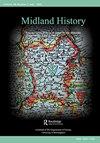The Loughborough ‘Mansfield Hosiery’ Strike, 1972: Deindustrialization, Post-war Migration, and Press Interpretation
IF 0.1
Q3 HISTORY
引用次数: 0
Abstract
ABSTRACT Recent historiographical trends have ensured the continued relevance of the strike at the Mansfield Mills’ hosiery factory in Loughborough in 1972. How this dispute, one of three in the East Midlands in two years dubbed ‘race strikes’ by the press, gained notoriety and were interpreted as an exemplar of British working-class racism requires re-evaluation. The article uses sources underutilized in previous studies, including the archive of the National Union of Hosiery and Knitwear Workers (NUHKW), to better understand the industry, the traditions of the hosiery craft, and how its processes of training and promotion differed from other industries that experienced ‘race strikes’. This article relocates the dispute within the processes of deindustrialization, demographic and social change, workplace culture, and the importance of press reportage in shaping interpretations.拉夫堡“曼斯菲尔德袜子”罢工,1972:去工业化,战后移民,和新闻解释
摘要最近的历史趋势确保了1972年拉夫堡曼斯菲尔德米尔斯袜厂罢工的持续相关性。这场争端是东米德兰地区两年内发生的三起被媒体称为“种族罢工”的争端之一,它如何臭名昭著,并被解读为英国工人阶级种族主义的典范,需要重新评估。这篇文章使用了以前研究中未充分利用的资料,包括全国袜业和针织品工人联合会(NUHKW)的档案,以更好地了解该行业、袜业工艺的传统,以及其培训和推广过程与其他经历过“种族罢工”的行业有何不同。本文将争议重新定位在去工业化、人口和社会变化、工作场所文化以及新闻报道在形成解释中的重要性的过程中。
本文章由计算机程序翻译,如有差异,请以英文原文为准。
求助全文
约1分钟内获得全文
求助全文

 求助内容:
求助内容: 应助结果提醒方式:
应助结果提醒方式:


